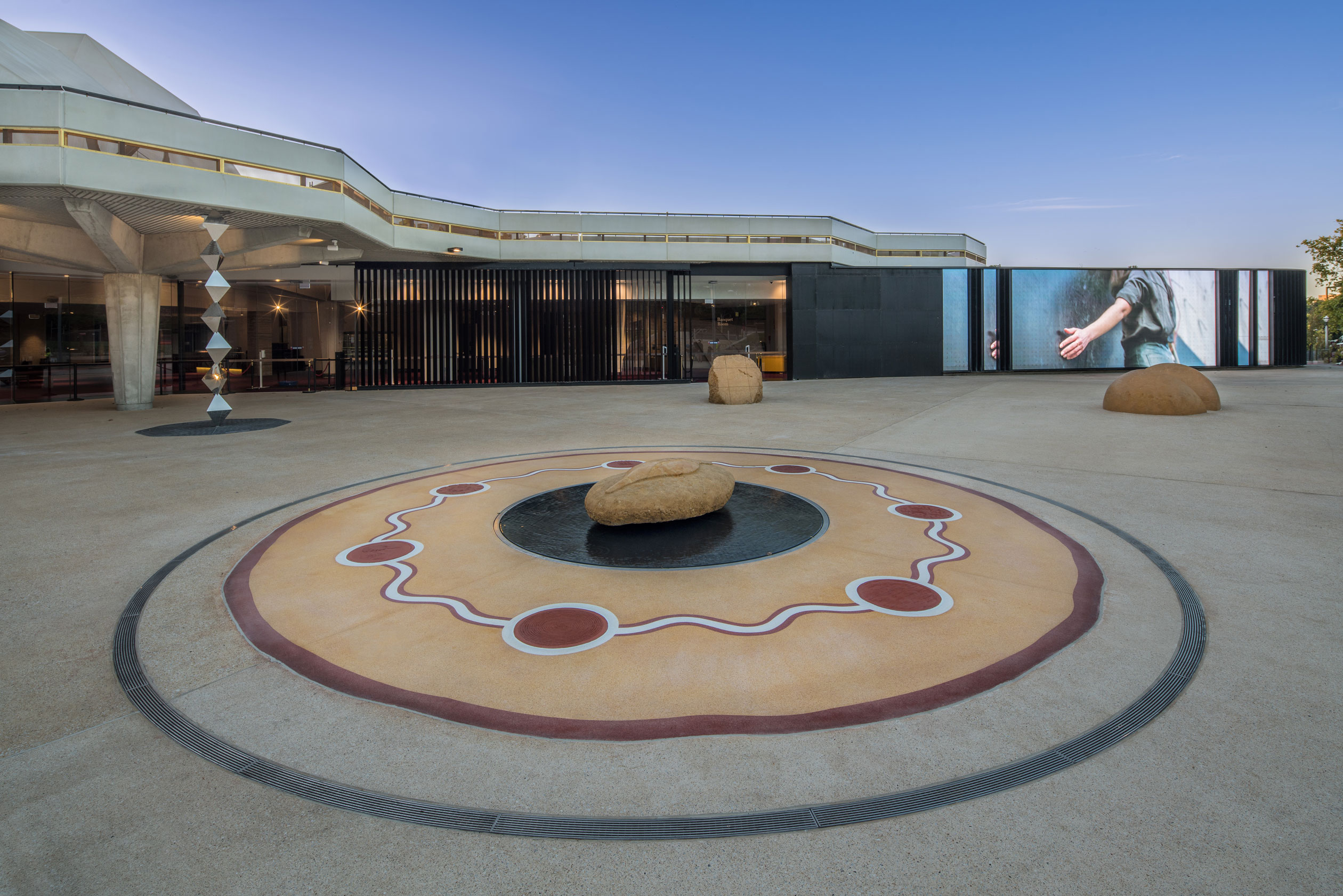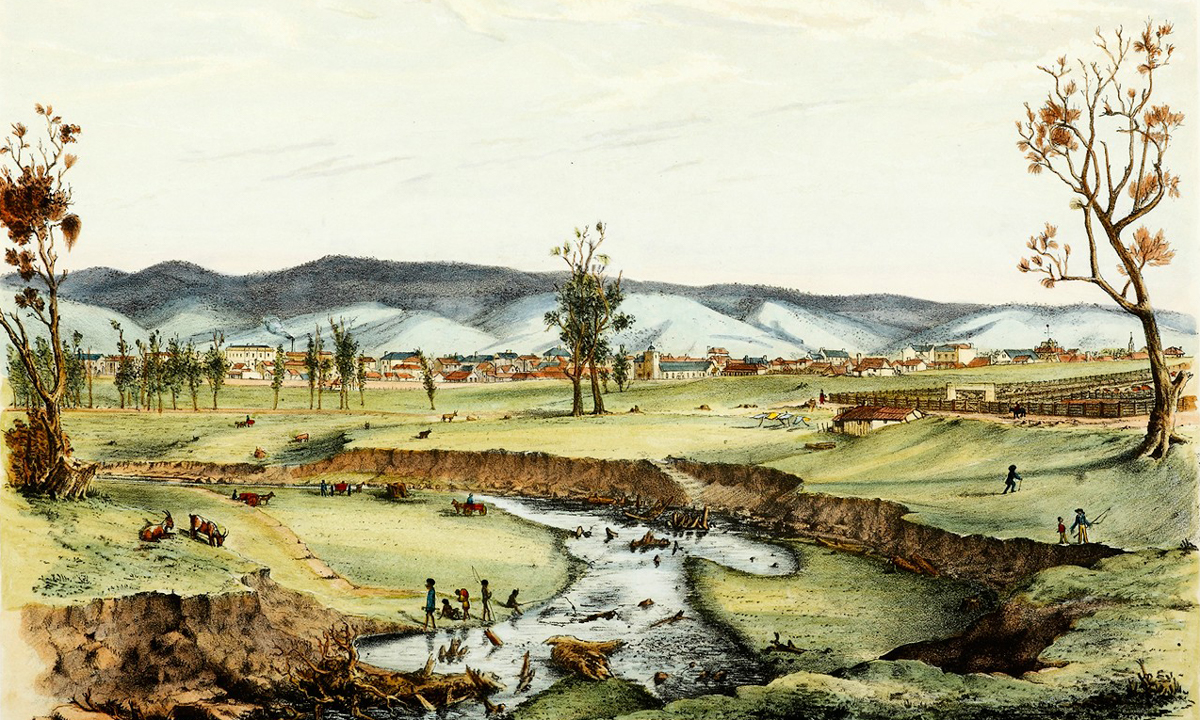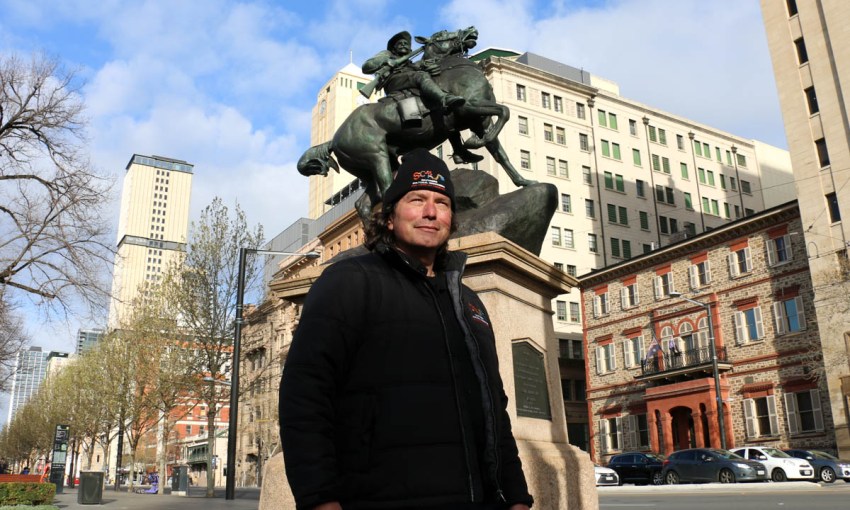Aboriginal man Elijah Bravington is leading eye-opening Indigenous-informed tours of the city for the Nature Festival, and says patrons should be ready to see their city in a more honest light.
‘They should expect a little bit of truth’
In a time when emus and kangaroos roamed Tartanya (now Adelaide Plains) in abundance, Tarnda Kanya was a large rocky outcrop standing tall on the southern banks of Karrawirra Pari River Torrens. This place was used by Kaurna meyunna (people) for the Red Kangaroo Dreaming.
The site was associated with secret Kaurna men’s business, and this traditional knowledge from surrounding the area is today mostly “complex and confidential,” so says an Adelaide City Council management plan for the nearby park Tarndanya Womma.
But the sandy limestone rock this important cultural site is made from was quarried and used to build colonised Adelaide. These bits of stone were most likely used to fortify and construct the Old Adelaide Goal (in 1841) and old Parliament House (in the 1840s).
Now, the only physical reminder of the sacred place is what is on display at the front of the Adelaide Festival Centre. As part of the Kaurna Reconciliation Sculptures constellation, the limestone harks back to what once was.

The boulder is at the back. This picture: Naomi Jellicoe
Arabana man Elijah Bravington is a tour guide at Southern Cultural Immersion – an Aboriginal-owned business offering culturally appropriate experiences, spanning school tours to smoking ceremonies, celebrating First Nations stories and people.
Elijah speaks to CityMag on the steps of North Terrace’s Parliament House on a wet Friday afternoon. While talking about Tarnda Kanya, he says you can interpret the act of slicing up and taking the sacred ‘red kangaroo rock’ stone to build modern-day Adelaide in many ways.
“It depends on your point of view,” he says.
“It was a desecration of a very, very important site.
“But then, if you wanted to think about it, well, that spirit then went into these other houses and these other places.”
Parliament House is the first of three major stops on Southern Cultural Immersion’s Adelaide CBD Cultural Tour. This experience is part of the 10-day Nature Festival, which aims to celebrate South Australia’s environmental landscape and surrounds. The program consists of events, talks and exhibitions.
After stopping at Parliament House, we will continue our tour to the Adelaide Festival Centre on King William Street — where the rocky outcrop once was — and the Aboriginal and Torres Strait Islander War Memorial, near Elder Park. The tour is billed online as an opportunity to learn about the “wonderful and tragic colonial history of our state’s capital”.
While walking around contemporary Adelaide, Elijah says participants “should expect a little bit of truth”.
“Once upon a time, this was all Aboriginal owned; there was no homelessness, people were not worried about inflation, they didn’t care what their interest rates were because everybody had an abundance of everything,” he says.
“Nowadays, not so much the same. [But] we got all these social issues.”
—Elijah Bravington
The Uluru Statement from the Heart is a national political movement calling for the establishment of a First Nations Voice in the Australian Constitution. It also requests a commission to oversee decision-making and truth-telling between governments and First Nations people.
Truth-telling is “crucial to the ongoing process of healing and reconciliation in Australia,” a 2018 Federal Government report states.
“The history, tradition and culture of Aboriginal and Torres Strait Islander peoples and their experiences of injustices following colonisation has been largely unknown.
“However, there is a growing momentum among Australians to develop a fuller understanding and awareness of our history.”
Elijah wants this tour to fill the local truth-telling gap, and give non-Aboriginal people historical insight into the place they call home.
While walking down the King William Street hill, which declines towards the Adelaide Festival Centre, Elijah says he wants to use the past to serve as a springboard to explore the contemporary landscape.
“We want to demystify any misunderstandings that they might have,” Elijah says.

A lithograph of Adelaide by Samuel Calvert
As an example, Elijah refers to Karrawirra Pari. Prior to the city being filled with large buildings, bridges and towers, which have flooded the airspace with light pollution, the river mirrored the Milky Way. The bright lights of the constellation were seen as campsites along the river.
Nearby is Adelaide Oval – the 2100sqm sporting ground. Racist on-field experiences, described by Indigenous footy players Eddie Betts and Adam Goodes, cast a dark shadow over the stadium, Elijah says.
“The game was pretty much stolen from Aboriginal people,” he adds.
“We need to see more coaches, more commentators. We need to permeate through rather than just being racehorse lackeys for the industry.”
Walking to our last stop, Elijah – an environmental scientist by trade – refers to Kaurna Elder Frank Wanganeen as a pioneer in Adelaide’s walking city tours.
For his expeditions though, Elijah relies on oral and written histories to inform his knowledge. To guide his tour, he continuously trawls through records and other ephemera at the State Records of South Australia, the State Library of South Australia, museums, art galleries, and Botanic Gardens of South Australia for information.

Elijah near the Aboriginal and Torres Strait Islander War Memorial
Although these are predominantly “white” spaces, Elijah takes the facts away and injects it with “a little bit of colour”. He brings these composite histories to the pavement of postcode 5000.
The Aboriginal and Torres Strait Islander War Memorial, unveiled along the banks of the Torrens Parade Ground in 2013, is our final destination. This site is important, Elijah says, because there are few national monuments recognising Aboriginal peoples’ sacrifices in wartime.
“Even though our country was occupied and even though they staged resistance – and we still seek self-determination, wanting to get out from under the foot of oppression of white civilisation – [Indigenous] people were still happy enough to go and fight for their country,” he explains.
“I think that’s amazing.”
The contrast between how Aboriginal and non-Aboriginal veterans were treated once they returned home needs to be remembered, Elijah says.
“All the other white guys have 40 acres and a mule, or whatever it was. We just head back to a mission,” he says.
But the tour doesn’t only focus on low periods in Adelaide’s history. Elijah also takes the opportunity to spotlight the power of Aboriginal people. This includes the 1967 Australian referendum. Due to overwhelming supportive votes, Aboriginal and Torres Strait Islander people were included in the census and within “good government” laws.
“We’ve seen in the ’67 referendum that people were saying, ‘Well, yes, we want to see Aboriginal people counted who want to have laws made for them’,” Elijah says.
“Now, hopefully, we’re going to see the Uluru Statement from the Heart recognised.
“Hopefully, we’re going to see Australians really meet their potential and say, ‘Yeah, yeah, that makes perfect sense’.”




